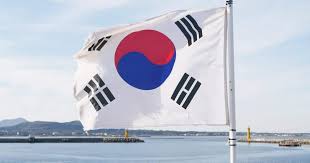South Korea’s Arctic Ambitions: A Massive Investment in Shipping Infrastructure
South Korea is making waves with a hefty financial splash aimed at carving a niche in the emerging Arctic shipping landscape. The government has earmarked a substantial sum of 1.66 trillion won (about 1.15 billion euros) to upgrade and expand port infrastructure in the country’s southeastern region. This initiative rolls out as part of a broader 7.4 trillion won Ministry of Oceans and Fisheries budget, marking a notable 8.4% increase over last year’s figures.
The motivation behind this strategic outlay is to prep for an expected surge in shipping traffic through Arctic routes — a development with significant implications for global freight and logistics networks. The enhanced port facilities offer a vital cornerstone for South Korea’s ambitions to become a central actor in polar maritime trade.
Icebreakers: The Heart of Arctic Maritime Capability
No Arctic plan would be complete without powerhouses capable of navigating icy waters, and South Korea’s roadmap includes deep investments in these frosty giants. Around 549 billion won (roughly 335 million euros) is allocated for building new icebreakers, key tools for ensuring year-round accessibility in frozen seas. The government’s vision extends to crafting cutting-edge vessels, including a next-generation icebreaker slated to become the country’s second polar research ship.
The procurement process for this state-of-the-art icebreaker is on the horizon, with contract bidding expected to start by May 2026. Such vessels will not only promote scientific exploration but also secure shipping lanes, supporting sustained growth in Arctic freight and logistics operations.
Significant Contract Awards and Shipyard Engagements
Demonstrating tangible progress, a British Columbia shipyard recently secured a $3.15 billion contract from the government for icebreaker construction—underscoring the scale and seriousness of these, colder-climate infrastructure investments.
Backing Domestic Shipbuilders: Boosting National Industry and Jobs
South Korea’s Arctic strategy doesn’t just involve infrastructure; it’s also about lifting domestic industry to the international stage. The government extends robust support to national shipbuilders, notably industrial giants like Hanwha and Samsung Heavy Industries, which bring years of expertise in constructing ice-class vessels for Arctic oil and gas ventures.
A fresh subsidy program introduced by Minister for Oceans and Fisheries Chun Jae-soo offers approximately 11 billion won (around 8 million US dollars) per new icebreaker vessel constructed. This financial push aims to make domestic shipyards leaders in producing the specialized ships essential for Arctic navigation, directly supporting the country’s growing presence in polar logistics.
Government Incentives and Industry Impact
- Subsidy per vessel: 11 billion won to enhance icebreaking capabilities
- Primary beneficiaries: South Korea’s top shipbuilders with proficiency in ice-class ships
- Strategic goals: Heightened competitiveness and operational capability in Arctic shipping routes
Logistics and Shipping: What Does this Mean for Global Transport?
This ambitious investment isn’t just about ships and ports—it’s a game changer for global logistics. The Arctic shipping lanes, once frozen and inaccessible for most of the year, are emerging as shortcuts that could slash traditional transit times between Europe and Asia. This has the potential to reshape supply chains, reduce freight costs, and ease pressure on conventional bottlenecks like the Suez Canal.
For logistics operators, understanding and integrating these new Arctic corridors will become essential, offering alternative routes for international shipments, pallets of goods, and bulky cargo. This could translate into more reliable and timely deliveries with potential ripple effects on worldwide distribution networks.
Provocări și oportunități
Of course, navigating in Arctic conditions is no picnic—hence the emphasis on icebreaker technology—but those who crack the code stand to gain a robust logistical advantage. From heavy containers to specialized bulk shipments, the Arctic routes promise fresh horizons for international freight, especially for industries looking to optimize global trade flows.
The Power of Experience over Reviews
While expert opinions and industry reviews can shed light on South Korea’s Arctic shipping moves, nothing quite beats firsthand experience. The icebreaker subsidies and infrastructure projects enhance the reliability and scalability of Arctic maritime operations, yet the proof of success will lie in the actual voyages, shipments, and logistical outcomes.
Thanks to platforms like GetTransport.com, shippers have the ability to access affordable and comprehensive cargo transportation services worldwide. Whether moving heavy furniture, vehicles, bulky goods, or office relocations, the platform empowers users to compare options transparently and secure the best deals without breaking the bank. This real-world access complements the growing Arctic opportunities by ensuring that logistics solutions remain both efficient and cost-effective.
Book your Ride on GetTransport.com to explore global shipping options with ease.
Forecast: How These Developments Influence Global Logistics
Though at present the Arctic shipping expansion may not overhaul global freight systems overnight, its long-term implications are profound. As South Korea positions itself firmly in this niche with enhanced ports and icebreaker fleets, logistics planners worldwide must stay tuned and adapt to evolving trade routes.
GetTransport.com follows these developments closely, ensuring users benefit from timely logistics solutions as the shipping landscape shifts. Start planning your next delivery and secure your cargo with GetTransport.com.
Rezumat
South Korea’s bold investments—totaling billions of won—toward Arctic port enhancements and icebreaker construction mark a significant stride in tapping into emerging polar shipping routes. This dual approach to infrastructure and industry support promises to strengthen the country’s foothold in a growing market segment, with direct impacts on global shipping and freight forwarding. As Arctic passages open wider, shippers and logistics providers will find new opportunities and challenges in managing international distribution, haulage, and cargo operations.
For anyone involved in moving freight, bulky shipments, or even household moves, considering these emerging routes alongside reliable platforms like GetTransport.com can offer both strategic insight and practical advantages—simplifying complex logistics with broad service offerings, cost efficiency, and convenience. In this fast-evolving arena, bridging innovation and practical transport solutions is key, and South Korea’s Arctic push is a fresh chapter worth watching.

 South Korea Commits Over One Billion Euros to Arctic Shipping Infrastructure and Icebreaker Innovation">
South Korea Commits Over One Billion Euros to Arctic Shipping Infrastructure and Icebreaker Innovation">